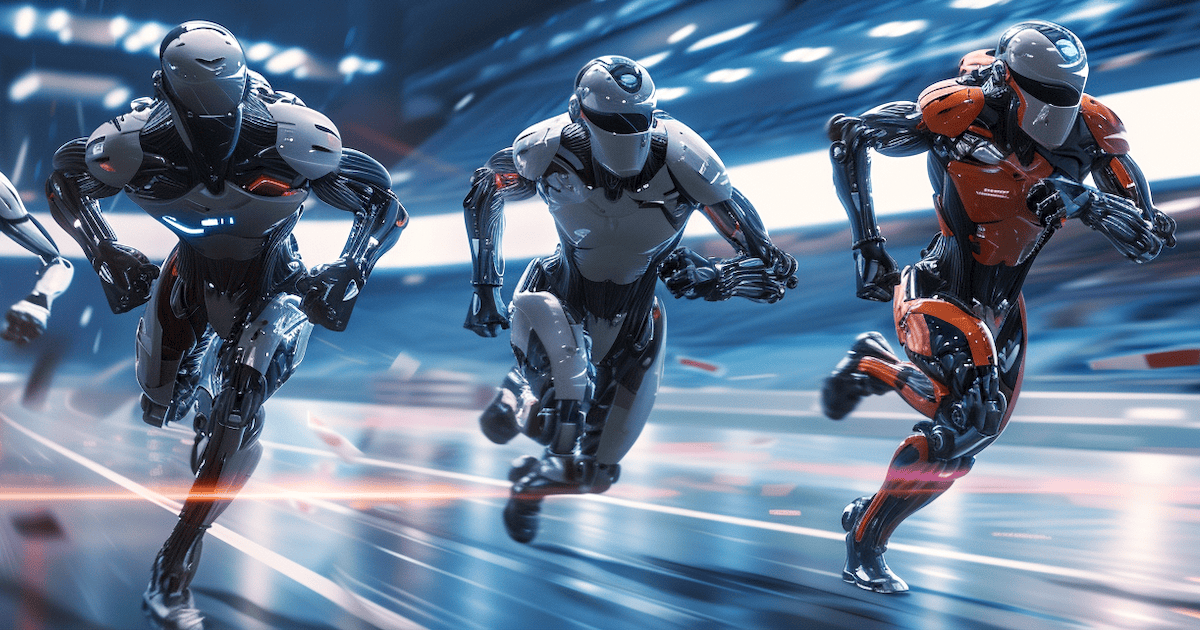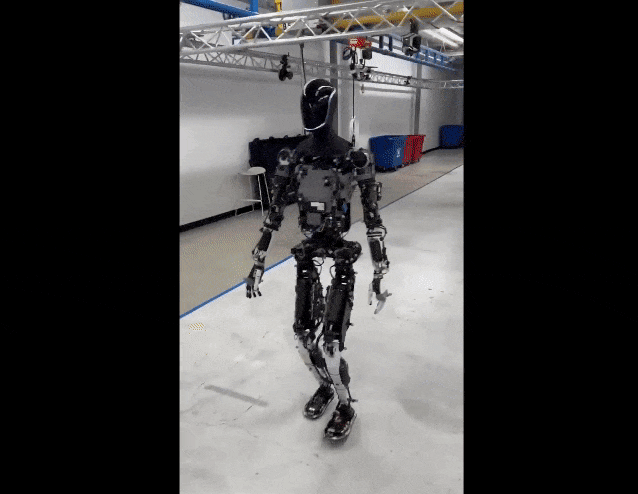
They’re taking Optimus seriously now.
So much so that they are scrambling to align themselves with a potential competitor.
On January 30th, the news came out that Figure AI, a company we know well here at Outer Limits, is looking to raise $500 million.
The funds will support Figure AI’s next phase of growth needed to develop artificial intelligence (AI) powered humanoid robots.

We most recently had a look at Figure AI in January, on news that BMW “hired” its first humanoid robot.
We explored Figure’s recent agreement with BMW to deploy the company’s “01” robots at the BMW manufacturing facility in Greer, South Carolina.
It was a first of its kind deal that envisions Figure 01 robots working side-by-side with human workers on BMW’s factory floors.
This isn’t something that will happen years in the future, either. The deal provides for deployment of Figure 01s within 12 months.
It wasn’t the $500 million sum that was interesting about the current raise, though…
After all, large raises like this into exciting, early stage tech companies is quite normal. Especially when they involve AI.
What is interesting is who intends on investing in this round.
The word is that Microsoft is in for $95 million…
And OpenAI is in for $5 million.
Combined, they’ll be taking up 20% of Figure’s latest round. That assumes that the round size will remain at $500 million.
The investment is reportedly happening at a $1.9 billion pre-money valuation, which means a $2.4 billion post-money valuation for a company that was only capitalized in January of 2022.
$0 to a $2.4 billion valuation in two years with no revenue — wow!
What a compliment to Elon Musk and his robotics team at Tesla.
After all, only a few months ago, the media was saying things like this about Tesla’s Optimus robot…
“but A.I. Experts have their doubts”
(when referencing Musk’s plan to start production next year)
“Is it the ‘friend’ Elon Musk says will cost ‘much less than $20,000’ and allow for ‘a future where there is no poverty?’ Probably not.”
“[…] it’s best to take Tesla’s claims with a grain of salt until they are independently verified in practical, real-world demonstrations.”
We covered Tesla’s most recent progress update regarding Optimus on December 14th, What the Mainstream News is Still Missing About Tesla.
The reality is, Microsoft has been shaking in its boots.
Because the truth is that while the mainstream messaging around Tesla’s progress with Optimus has been skeptical, the tech industry is scrambling, realizing how far behind they really are.
Hence the investment. Now they have to pay to play.
The proof of Tesla’s progress with Optimus is obvious.
While Tesla isn’t opening its doors to competitors to “come and check out its technology” (who would do that anyway?), we can see the progress in the pace of development.
The frequency of what Tesla is sharing has been increasing…
And it’s impressive.
Just since the December progress update, here is what Optimus is capable of doing now:

Above is a video of Optimus walking with a human-like gait completely untethered. The mobility and speed of the gait are impressive, and the stride is strong. There is no instability. This is far better than what was demonstrated in December.
And a couple weeks before the Optimus team posted that video, it shared the below video demonstrating some of Optimus’ fine motor skills:

Optimus demonstrates its ability to fold a shirt in about 25 seconds perfectly. Crazy. You can watch the full video here.
I completely recognize that you and I could do that same task in about five seconds. But that misses the point.
Two months ago, Optimus couldn’t fold a shirt at all, and it couldn’t walk safely untethered for a long distance at the current speed.
Just imagine what it will be doing two months from now.
Twenty-five seconds will probably shrink to 10 seconds, and I wouldn’t be surprised if Optimus will be capable of a hop, skip, and a jump by then.
But regardless of what Optimus is capable of doing today, it’s not today’s capabilities that Tesla’s competition is watching…
It’s Tesla’s rate of improvement that has everyone running scared.
And Microsoft has been in this position before. They see the writing on the wall.
Microsoft has learned its lessons the hard way.
It already failed miserably on search — ceding the search engine market to Google.
It was caught way behind in providing cloud services by another Seattle-based company — Amazon.
What made that such an embarrassment was that Amazon wasn’t even an information technology company like Microsoft. Amazon beat both Microsoft and Google to the punch.
Microsoft also failed miserably with mobile devices.
It acquired Nokia’s mobile phone business back in 2013 for $7.2 billion. By 2015, Microsoft wrote off $7.6 billion related to the purchase and admitted failure.
Microsoft lost out to both Apple’s iPhone and Google’s Android-based operating system (OS), which now has the majority of the world’s mobile phone market share.
Ouch. Ouch. Ouch.
And if that history wasn’t embarrassing enough, Microsoft suffered a similar fate with its efforts to develop AI technology. So much so that it — smartly — has invested about $13 billion in OpenAI over the last few years.
Today, Microsoft effectively has control over OpenAI in one of the most unusual deal structures that I’ve ever seen.
Early investors will receive all of OpenAI’s profits until their original investments are paid back in full.
This is very rare in venture capital. Typically, money doesn’t come back to investors until there is an acquisition or an IPO.
Occasionally, companies allow for investors to sell a portion of their shares in a secondary offering, but that’s not the norm.
Once the early investors are paid back, Microsoft will receive 75% of all OpenAI profits until Microsoft’s entire investment has been paid back.
After that, 49% of future OpenAI profits belong to Microsoft. This can amount to as much as $92 billion for Microsoft over time.
Despite the structure of the Microsoft/OpenAI deal, Microsoft was very careful to signal externally that they have no control over OpenAI.
We initially discussed Microsoft’s “Smoke and Mirrors” strategy in The Driver’s Behind Sam Altman’s Ousting. It’s a must-read.
For example, Microsoft only has a non-voting board seat at OpenAI. This gives the impression that Microsoft is just an observer.
This is done for a reason.
OpenAI, seen by many, is one of the most advanced and powerful AI companies in the world. It has a clear product roadmap and goal to develop the first sentient artificial intelligence. And its impressive progress suggests that is possible.
That makes an outright acquisition of OpenAI by Microsoft nearly impossible. Any effort to outwardly control OpenAI would be met by intense scrutiny by governments around the world. Hence the unusual deal structure.
Done this way, Microsoft gains access to the software code that makes up OpenAI’s AI technology, with which is it actively deploying across its consumer and enterprise products.
Which brings us back to the proposed investment in Figure AI.
I’ve suggested that the potential market size for intelligent humanoid robots is around $25 trillion.
And the market potential spans both enterprise and consumer applications. After all, Optimus can already fold shirts…
Microsoft doesn’t want to miss out, yet again, on one of the largest market opportunities in history. It needs to invest to catch up.
And clearly it sees Figure AI as the company that is currently representing the closest competitor to Tesla’s Optimus.
Meanwhile, when combined with Figure AI, OpenAI could bring some much needed AI that’s already operating at the outer limits.
The Optimus and Figure 01 robotic hardware might look similar…
But Tesla is leaps and bounds ahead of Figure AI on the software — the intelligence.
OpenAI can help close that gap.
And while we don’t know the terms of the investment, Microsoft may have some hooks into Figure AI, in exchange for the investment, that provide for cooperation on operating systems, consumer applications, enterprise applications, or even perhaps sales and distribution.
Will this be the first move into robotics by Microsoft? I seriously doubt it.
I’d be willing to bet that Microsoft offered Figure AI a lot more than $100 million. But I suspect Figure said no.
Raising capital isn’t a problem for a company like Figure in a market that is thirsty for AI startups.
The decision becomes more about who you raise capital from…
Which raises another question…
What about the other tech giants wanting to gain a foothold into the humanoid robotics space? Market set ups like this dictate that investments are made, and the big players choose sides.
Microsoft is aligning with Figure AI.
What about Google? Or Apple? Samsung? Or Meta?
Next week, let’s plan on finding out what these companies are up to, as well.
We’ll figure out who’s in the race to catch up to Optimus…
And who is being left behind.
We’ve welcomed a wave of new Outer Limits readers recently. If you’re just tuning in for the first time, welcome. We’d like to point you to our recently published FAQ, which you can access right here.
If you have any questions, comments, or feedback, we always welcome them. We read every email and address the most common threads in the Friday AMA. Please write to us here.